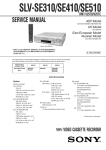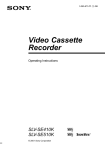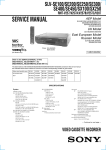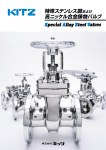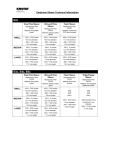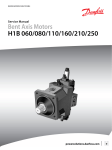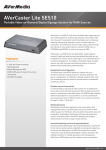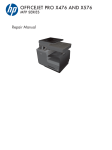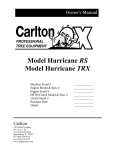Download SLV-SE5102015-05-09 01:30486 KB - Wiki Karat
Transcript
SLV-SE310/SE410/SE510 RMT-V257B/V257C SERVICE MANUAL AEP Model SLV-SE310D/SE510B/D/SE510D UK Model SLV-SE310I East European Model Russian Model SLV-SE410K/SE510K Photo: SLV-SE510 • Refer to the SERVICE MANUAL of VHS MECHANICAL ADJUSTMENTS VI for MECHANICAL ADJUSTMENTS. (9-921-647-11) S MECHANISM The abbreviations of SE310/SE410/SE510 contained in this service manual are indicated when these models are common to all their corresponding models as given below. Abbreviated models name All model names SLV- SE310 SE310D SE310I SE410 SE410K SE510 SE510B SE510D SE510K SPECIFICATIONS System Channel coverage SLV-SE310I PAL (I) VHF IA to IJ, SA10 to SA13 UHF B21 to B69 CATV S01 to S05, S1 to S20 HYPER S21 to S41 SLV-SE410K/SE510K PAL (B/G, D/K) VHF E2–E12, R1–R12 UHF E21–E69, R21–R69 CATV S1–S41, S01–S05 SLV-SE310D/SE510D PAL (B/G) VHF E2 to E12 VHF Italian channel A to H 0 UHF E21 to E69 CATV S01 to S05, S1 to S2 HYPER S21 to S41 SLV-SE510B SECAM (L) : VHF F2 to F10 UHF F21 to F69 CATV B to Q HYPER S21 to S41 PAL (B/G) : VHF E2 to E12 VHF Italian channel A to H UHF E21 to E69 CATV S01 to S05, S1 to S20 HYPER S21 to S41 RF output signal UHF channels 21–69 Aerial out 75-ohm asymmetrical aerial socket Tape speed SP: PAL/MESECAM 23.39 mm/s (recording/playback) SECAM 23.39 mm/s (recording/playback) NTSC 33.35 mm/s (playback only) LP: PAL/MESECAM 11.70 mm/s (recording/playback) SECAM 11.70 mm/s (recording/playback) NTSC 16.67 mm/s (playback only) EP: NTSC 11.12 mm/s (playback only) – Continued on next page – VIDEO CASSETTE RECORDER Maximum recording/playback time 10 hrs. in LP mode (with E300 tape) Fast-forward and rewind time Approx. 3 min. (with E180 tape) Inputs and outputs i LINE-1 (TV) 21-pin Video input: pin 20 Audio input: pins 2 and 6 Video output: pin 19 Audio output: pins 1 and 3 DECODER/t LINE-2 IN 21-pin Video input: pin 20 Audio input: pins 2 and 6 General Supplied accessories Power requirements 220 – 240 V AC, 50 Hz Power consumption 18 W 1.5 W (POWER SAVE is set to ON, minimum) Operating temperature 5°C to 40°C Storage temperature –20°C to 60°C Dimensions Approx. 355 × 96 × 288 mm (w/h/d) including projecting parts and controls Mass Approx. 3.7 kg Remote commander (1) R6 (size AA) batteries (2) Aerial cable (1) Design and specifications are subject to change without notice. SAFETY-RELATED COMPONENT WARNING!! COMPONENTS IDENTIFIED BY MARK 0 OR DOTTED LINE WITH MARK 0 ON THE SCHEMATIC DIAGRAMS AND IN THE PARTS LIST ARE CRITICAL TO SAFE OPERATION. REPLACE THESE COMPONENTS WITH SONY PARTS WHOSE PART NUMBERS APPEAR AS SHOWN IN THIS MANUAL OR IN SUPPLEMENTS PUBLISHED BY SONY. SAFETY CHECK-OUT After correcting the original service problem, perform the following safety checks before releasing the set to the customer: 1. 2. 3. 4. Look for parts which, through functioning, show obvious signs of deterioration. Point them out to the customer and recommend their replacement. 5. Check the B+ voltage to see it is at the values specified. 6. Flexible Circuit Board Repairing • Keep the temperature of the soldering iron around 270˚C during repairing. • Do not touch the soldering iron on the same conductor of the circuit board (within 3 times). • Be careful not to apply force on the conductor when soldering or unsoldering. Check the area of your repair for unsoldered or poorly-soldered connections. Check the entire board surface for solder splashes and bridges. Check the interboard wiring to ensure that no wires are "pinched" or contact high-wattage resistors. Look for unauthorized replacement parts, particularly transistors, that were installed during a previous repair. Point them out to the customer and recommend their replacement. –2– TABLE OF CONTENTS Section Title Page Section SERVICE NOTE ...................................................................... 4 1. INTERFACE, IC PIN FUNCTION DESCRIPTION 5-1. System Control-Video/RP Block Interface (MA-401 BOARD IC162) ............................................... System Control-Servo Peripheral Circuit Interface (MA-401 BOARD IC162) ............................................... System Control-Mechanism Block Interface (MA-401 BOARD IC162) ............................................... System Control-System Control Peripheral Circuit Interface (MA-401 BOARD IC162) ................................ System Control-Audio Block Interface (MA-401 BOARD IC162) ............................................... Servo/System Control Microprocessor Pin Functions (MA-401 BOARD IC162) ............................................... Mode Control Pin Functions (MA-401 BOARD IC420) ............................................... 5-2. 5-3. 5-4. 2. DISASSEMBLY 2-1. 2-2. 2-3. 2-4. 2-5. 2-6. 2-7. 2-8. Upper Case Removal .................................................... Front Panel Section Removal ........................................ Power Block (ETXNY272E2D) Removal ....................... Rear Panel Removal ..................................................... Mechanism Deck Removal ........................................... MA-401 Board Removal ................................................ Internal Views ................................................................ Circuit Boards Location ................................................. 3. BLOCK DIAGRAMS 3-1. 3-2. 3-3. 3-4. 3-5. Overall Block Diagram ................................................... Video Block Diagram ..................................................... Servo/System Control Block Diagram .......................... Audio/Tuner Block Diagram ........................................... Power Block Diagram .................................................... 4. PRINTED WIRING BOARDS AND SCHEMATIC DIAGRAMS 4-1. 4-2. Frame Schematic Diagram ............................................ Printed Wiring Boards and Schematic Diagrams ......... MA-401 Printed Wiring Board ....................................... MA-401 (Head Amp) Schematic Diagram .................... MA-401 (Video, Audio) Schematic Diagram ................. MA-401 (SECAM) Schematic Diagram ......................... MA-401 (Servo/System Control) Schematic Diagram ....................................................... MA-401 (I/O) Schematic Diagram ................................. MA-401 (Tuner) Schematic Diagram ............................ MA-401 (Mode Control) Schematic Diagram ................ MA-401 (Power Supply) Schematic Diagram ............... KK-26 Schematic Diagram ............................................ KK-26 Printed Wiring Board .......................................... ETXNY272E2D Printed Wiring Board ........................... ETXNY272E2D Schematic Diagram ............................ 5-5. 5-6. 2-1 2-1 2-1 2-1 2-2 2-2 2-3 2-4 Page 5. GENERAL Getting Started .............................................................. 1-1 Basic Operations ........................................................... 1-10 Additional Operations .................................................... 1-15 Title 5-7. 4-3 4-5 4-5 4-9 4-11 4-15 4-17 4-21 4-23 4-25 4-27 4-29 4-29 4-30 4-31 5-2 5-2 5-2 5-3 5-5 ERROR CODES ....................................................... 6-1 7. ADJUSTMENTS 8. 7-1 7-1 7-1 7-1 7-1 7-1 7-1 7-2 7-2 7-2 7-2 7-3 7-3 7-3 7-3 7-3 7-3 7-3 7-4 REPAIR PARTS LIST 8-1. Exploded Views ............................................................. 8-1-1. Front Panel and Cabinet Assemblies ....................... 8-1-2. Chassis Assembly .................................................... 8-1-3. Mechanism Chassis Assembly (1) ........................... 8-1-4. Mechanism Chassis Assembly (2) ........................... 8-1-5. Mechanism Chassis Assembly (3) ........................... 8-2. Electrical Parts List ....................................................... –3– 5-1 6. 7-1. Mechanical Adjustments ............................................... 7-2. Electrical Adjustments ................................................... 2-1. Preparation Before Adjustments ................................... 2-1-1. Equipment Required ................................................ 2-1-2. Equipment Connection ............................................. 2-1-3. Set-up of Adjustment ............................................... 2-1-4. Alignment Tapes ....................................................... 2-1-5. I/O Level and Impedance ......................................... 2-1-6. Adjustment Sequence .............................................. 2-2. Power Supply Check ..................................................... 2-2-1. Output Voltage Check .............................................. 2-3. Servo System Check ..................................................... 2-3-1. RF Switching Position Adjustment ........................... 2-4. Audio System Adjustments ........................................... 2-4-1. Normal Audio System Adjustment ........................... 2-4-2. ACE Head Adjustment ............................................. 2-4-3. E-E Output Level Check ........................................... 2-4-4. Frequency Response Check .................................... 2-5. Adjusting Parts Location Diagram ................................ 3-1 3-3 3-5 3-7 3-9 5-1 8-1 8-1 8-2 8-3 8-4 8-5 8-6 SERVICE NOTE 1. DISASSEMBLY • This set can be disassembled in the order shown below. Note: Pages in Pages in indicated pages in the SERVICE MANUAL. indicated pages in the VHS MECHANICAL ADJUSTMENT MANUAL VI. Set Upper Case (Page 2-1) Front Panel Section (Page 2-1) Pinch Press Block Ass’y (Page 14) Ground Shaft Ass’y (Page 13) FL Complete Ass’y (Page 13) Mechanism Deck (Page 2-2) Drum Ass’y (Page 13) Retainer Plate (Page 22) Rubber Belt (Page 15) Rubber Belt (Page 15) MA-401 Board (Page 2-2) FL Slider Block Ass’y (Page 22) Capstan Motor (Page 15) Pully Gear Ass’y (Page 29) Rotary Switch Cam Gear (Page 23) Cam Motor Retainer (Page 31) Reel Direct Ass’y (Page 30) Rubber Belt (Page 15) Cam Motor (Page 31) Slider (Page 26) Loading Gear (T, S) (Page 28) –4– Rear Panel (Page 2-1) Power Block (ETXNY272E2D) (Page 2-1) Tuner Unit SLV-SE310/SE410/SE510 SECTION 2 DISASSEMBLY Note: Follow the disassembly procedure in the numerical order given. 2-1. UPPER CASE REMOVAL 1 Two screws (Case3 TP2) 2-3. POWER BLOCK (ETXNY272E2D) REMOVAL 3 Upper case 2 Power cord 2 Two screws (Case3 TP2) 3 Three screws (B3) 4 Power block (ETXNY272E2D) 1 Connector (CN101) 2-4. REAR PANEL REMOVAL 2-2. FRONT PANEL SECTION REMOVAL 7 Rear panel 6 Two claws 5 Three claws 1 Power cord 2 Three claws 2 Harness 4 Two claws 4 Front panel section 1 Connector (CN460) 3 Three claws 2-1 3 Two flat cables 2-5. MECHANISM DECK REMOVAL 3 Flat cable (FFM-001) 2 Flexible board 4 Flat cable (FAC-8) (ACE head) 1 Connector 8 Screw (FE head) 7 Screw (BVTP3 × 12) (BVTP3 × 12) 6 Claw 0 Mechanism deck 9 Screw (BVTP3 × 12) 5 Screw (B3) Note: When mounting the mechanism deck, first align mark on the rotary switch. 2-6. MA-401 BOARD REMOVAL 1 Three screws (B3) 2 MA-401 board 2-2 2-7. INTERNAL VIEWS Drum assembly (M901) (DZH-92D-R) 1-772-361-11 (SE310) Drum assembly (M901) (DZH-93D-R) 1-772-362-11 (SE410/SE510) FE head 1-500-471-11 Q101 Tape end sensor 8-729-043-84 Q100 Tape top sensor 8-729-043-84 D100 Tape top/end LED 8-719-048-26 Drum assembly (M901) (DZH-92D-R) 1-772-361-11 (SE310) Drum assembly (M901) (DZH-93D-R) 1-772-362-11 (SE410/SE510) M902 Capstan motor 1-698-971-11 M903 Cam motor assembly X-3947-577-1 2-3 2-8. CIRCUIT BOARDS LOCATION MA-401 VIDEO, AUDIO, I/O, SERVO/SYSTEM CONTROL, TUNER, MODE CONTROL ( ) KK-26 (DIAL TIMER) 2-4 2-4E POWER BLOCK (ETXNY272E2D) (POWER SUPPLY) SLV-SE310/SE410/SE510 SECTION 6 ERROR CODES 6-1. ERROR CODE INDICATION • Error codes are indicated using the lower 5 digits in the fluorescent display tube. “At this time, Colon “:”between character is not indicated.” Mode code indication when the error has occurred. Error code ERROR CODE 0 No error 1 Cam encoder error Loading direction 2 Cam encoder error Unloading direction 3 T reel error 4 S reel error 5 Capstan error 6 Drum error 7 Error on initializing 8 Cassette loading error 9 Reserve MODE CODE 0 Power-on eject 10 FWD x1 20 REW play 1 Power-on initial 2 Power-off elect 11 FWD x2 21 Cas. loading 12 CUE 22 Tape loading 3 Power-off stop 4 FF 13 PB-pause 23 Power-off loading 14 RVS-pause 24 Mecha. error (Power on) 5 REW 15 RVS x1 25 Power-on eject initial 6 REC 16 RVS x2 26 Power-off eject initial 7 REC-pause 17 REV 27 APC REC 8 Power-on stop 18 Power-off initial 28 9 PB 19 Mecha. error (Power off) 6-1 E Cas. loading (No auto PB check) SLV-SE310/SE410/SE510 SECTION 7 ADJUSTMENTS 2-1-3. Set-up of Adjustment In this adjustment, PAL pattern generator is connected with LINE2 input terminal. When check to tuner, connected AERIAL terminal. Check that the synchronizing signal of the Y signal has an amplitude of approximately 0.7 V and that the burst signal has an amplitude of approximately 0.3 V and its waveform is flat. And check that the level ratio of burst signal to “red” signal is 0.30 : 0.66. The video signal (color bar) used for electrical aligning this unit is shown in Fig. 6-2-2. 7-1. MECHANICAL ADJUSTMENTS For the mechanical adjustments, please refer to the “VHS MECHANICAL ADJUSTMENT MANUAL (S MECHANISM)” (9-921-647-11). 7-2. ELECTRICAL ADJUSTMENTS See the adjusting part location diagram from on page 7-4 for the adjustment. 2-1. White (75%) PREPARATION BEFORE ADJUSTMENTS 2-1-1. Equipment Required The measuring instruments used for this alignment include: 1) Monitor TV 2) Oscilloscope, dual-trace, bandwidth of 30 MHz or more, with delay mode (A probe 10:1 should be used unless otherwise specified.) 3) Frequency counter 4) PAL Pattern generator 5) Remote commander 6) Digital voltmeter 7) Audio generator 8) Audio level meter 9) Audio attenuator 10) Alignment tapes KRV-51P (PAL) Part No. : 8-192-955-57 Approx. 0.7 V 2-1-4. Alignment Tape • Contents of KRV-51P 1 2 3 4 VIDEO IN Video output (75Ω) Burst signal (Should be flat) Fig. 7-2-2 Color Bar Signals of Pattern Generator 2-1-2. Equipment Connection Unless otherwise specified, connect and adjust the measuring instruments as shown in the following diagram. VCR Red Horizontal sync signal Mode Pattern generator Approx. 0.3 V Approx. 0.3 V Monitor TV VIDEO OUT Fig. 7-2-1 7-1 SP LP Period Video signal Audio signal Normal Hi-Fi 7 minutes 3 minutes 7 minutes 3 minutes Color bar Monoscope Color bar Monoscope 400Hz (L/R) 400Hz 2-1-5. Input/Output Levels and Impedance Video input: LINE-1 (TV)/LINE-2 IN Input signal: 1 Vp-p, 75 ohms, unbalanced, sync negative Video output: LINE-1 (TV) Output signal: 1 Vp-p, 75 ohms, unbalanced, sync negative Audio input: LINE-1 (TV)/LINE-2 IN Input level: –7.5 dBs (0 dBs= 0.775 Vrms) Input impedance: more than 47 kilohms Audio output: LINE-1 (TV) Standard level: –7.5 dBs at load impedance 47 kilohms Output impedance: less than 10 kilohms 2-2. POWER SUPPLY CHECK 2-2-1. Output Voltage Check (MA-401 Board) Mode STANDBY 2-1-6. Adjustment Sequence The adjustments should be performed in the following sequence. Power Supply Check Servo System Adjustments Audio System Adjustments D5 V Check Measurement point Cathode of D606 Specified value 4.8 to 5.4 V Mode E-E –11 V Check Measurement point Corrector of Q602 Specified value SW +12 V Check –13.5 to – 9.5 V Measurement point Specified value IC601 pin 2 or corrector of Q612 11.7 to 12.3 V SW +5 V Check Measurement point Emitter of Q600 Specified value MTR12 V Check 4.8 to 5.4 V Measurement point Specified value Corrector of Q601 12.6 to 13.6 V SW +30 V Check Measurement point Corrector of Q720 Specified value 33.5 to 36.5 V [Check Method] 1) Each of these supply voltages must meet its specified value. 7-2 2-3. 2-4-1. Normal Audio System Adjustment • Make adjustment in the SP mode unless otherwise specified. Use a normal VHS cassette for an adjustment tape. • Set AUDIO MONITOR to normal. SERVO SYSTEM CHECK 2-3-1. RF Switching Position Adjustment (MA-401 Board) [Adjustment Purpose] To adjust the link of the A-ch and B-ch of the tape playback outputs. To make the unit compatible with other tapes and units. If this specification is not satisfied, the link will appear on the screen and the screen will be disrupted, etc. Mode Signal Playback Alignment tape: SP color bar portion Measurement point Measuring instrument CH1: CN262 pin 1 (PB RF) CH2: CN262 pin 2 (RF SWP) Oscilloscope Adjusting element Specified value Remote commander CH+/– A=minimize 2-4-2. ACE Head Adjustment Refer to the VHS mechanical adjustment manual NISM) (9-921-647-11). 2-5. ADJUSTING PARTS LOCATION DIAGRAM MA-401 BOARD (CONDUCTOR SIDE) LINE-1(TV) (S MECHA- CN500 CN262 1 5 2-4-3. E-E Output Level Check [Adjustment purpose] Confirm that the output level adjust the reference input is within the specification. [Adjustment Method] 1) Playback the alignment tape. 2) Short CN262 pin 5 to Ground. 3) Check that “A P” is indicated on FL display. 4) Adjust so that part A becomes minimized at CH +/–. 5) Write data in EEPROM by pressing PAUSE button. 6) The display “A P” disappears and then the Adjustment mode terminates. Mode Signal E-E 400 Hz, –6.3 dBs Measurement point Measuring instrument CN500 Pin 3 Audio level meter Specified value –6.3 ± 2 dBs E Q601 B [Check Method] 1) Input signal of 400 Hz and –6.3 dBs to the J480. 2) Check that the audio output level is –6.3 ± 2 dBs. 2-4-4. Frequency Response Check [Adjustment purpose] Confirm that the frequency characteristic is within the specification. A CH1 PB RF CH2 RF SWP Mode Signal REC and PB (SP mode) 400 Hz, –26.3 dBs 7 kHz, –26.3 dBs Measurement point Measuring instrument CN500 Pin 3 Audio level meter Specified value 0 ± 3 dB B Q600 E B E Q602 Note: Tape path adjustment must have been completed. [Confirmation Method] 1) Supply a signal of 400 Hz, –26.3 dBs to J481 AUDIO IN. 2) Connect the audio level meter to CN500 Pin 3. 3) Adjust the attenuator so that the audio level meter will indicate –26.3 dBs. 4) Make recording in the SP mode. 5) Set an audio line input signal to 7 kHz and make recording. 6) Playback a recorded portion, and measure output levels at 400 Hz and 7 kHz. 7) Confirm that the 7 kHz playback output level within a range of the 400 Hz playback output level 0 dB to ± 3 dB. Fig. 7-2-3 2-4. AUDIO SYSTEM ADJUSTMENTS [Connecting Instruments] CN500 3 A (L) OUT 4 A GND J481 AUDIO IN Audio oscillator 600 Ω Audio level meter or distortion meter 47 kΩ Attenuator VTR Fig. 7-2-4 7-3 7-4 E












